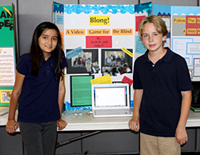Blindfolds On: Designing Video Games for the Visually Impaired
Two students in LA took an audible cue from the community for their fourth-grade science project and designed a sound-based video game. Their first video game design project gave them an inside look into how games are designed, built, and tested to meet the needs of various audiences.

There are countless angles for possible student exploration, and Science Buddies Video & Computer Games area offers a wide range of Project Ideas that encourage students to test, create, or experiment with video game design and technology.
Meeting Students on Familiar Ground
When Zach Weiss and Talia Glazer, fourth grade students at Brawerman Elementary School, discovered the "Creating a Video Game for the Blind" Project Idea after using the Topic Selection Wizard, they found a project that combined their interest in technology with their desire to help others. The Project Idea sparked their curiosity in terms of learning how to create a video game, but it also got them thinking about the video games they play. Can those same games be played by everyone? Do visually impaired students also play video games? Can games be created that are similarly fun for all audiences? For two fourth-grade students with no experience designing a video game, deciding to see what it takes to create a game that works for vision-impaired or blind players may sound ambitious, but Zach and Talia were up to the challenge.
With the support of their science teacher, who encouraged her students to investigate the implications of their projects beyond the walls of the classroom, Zach and Talia met with a group of teenagers at a local center for the blind. The team quickly learned that, like many other teens, students at the Center enjoy video games. Unfortunately, many games cannot be fully enjoyed (or won) if you can't "see" the game. The teens Zach and Talia met game them plenty of information about the kinds of features that are important in a game that can be played by blind gamers. "We asked them what elements they thought video games needed," says Zach. "They said lots of sound elements, commands, and cues, so we decided to create a video game with all of these elements."
Following the steps of the Engineering Design Process, Zach and Talia outlined their goals, brainstormed possible game types and storyboards, and evaluated game creation environments. After considering many options, they decided to create a game in the tradition of the classic two-paddle Pong. Though the team chose a vintage game as a conceptual framework, Zach and Talia planned to give their version a major update, one that would tip the scales in terms of sound cues and would not require sight to play. Using the "Creating a Video Game for the Blind" Project Idea and GameMaker Lite, they began developing Blong.
Designing Blong
Zach admits there was a learning curve to working with GameMaker. But the more they tested, tweaked, and retested their game during development, the easier they found the design and programming process. In the end, the two had a great time working together, exchanging ideas, and building a game that met their objectives.
"Our video game has tons of sound elements," says Zach. "For example, when the paddle 'bumps' into the top or bottom wall, the player hears a 'bump' sound." Cues like these, and other sound elements that signal certain actions or events, help orient the player both in terms of the game mechanisms and the game play. In addition to boosting the game's sound-based environment, Zach and Talia also paid careful attention to the speed of the game and the visual contrast of the game, elements of game design the teens they met told them can make or break the playability of a game for visually impaired players.
Testing Blong
Playtesting a game in development is often one of the most fun aspects of a game design project. For Zach and Talia, playtesting was critical, says Zach, but to accurately evaluate how the development was going, they had to continually put themselves in the position of their target audience. After all, they were not creating just a video game. They were making a game that can be successfully played entirely based on the game's sound cues. "We tested the game with our eyes closed in order to adjust the speed of the ball and paddle and to determine the types and amounts of sounds cues to use," says Zach. In addition to testing for playability, Zach and Talia also got a firsthand look at the rigorous levels of testing and troubleshooting that often go into game design and computer programming projects. "We tested each feature of the game throughout development," says Zach, "to make sure that it still worked, to determine if any of the newly added features conflicted with the earlier features, and to debug the errors that we found."
Creating Blong was challenging for the team, but the satisfaction of having made their own game scored big with the team in the end. "The best part of the science project," says Zach, "was programming the Blong video game that my partner and I developed!"
Science Projects Spark Lasting Interest
Zach loves to read, play video games, and participate in school sports and extracurricular activities like the Green Committee, school newspaper, choir, and orchestra. He was already interested in technology at the outset of his science project, but his experience with Blong cemented both his interest in pursuing a high-tech career and his enthusiasm for science fairs. "Creating a video game for the blind was an amazing experience," says Zach, attributing part of the reward to the community service aspect that gave his and Talia's project real-world significance.
Already Zach has continued to expand his knowledge of video game design and took a summer class to learn about using another popular game design creation tool. Blong may have been his and Talia's first science fair project and the first video game they designed, but we hope there are many games yet to be created in their future!
Categories:
You Might Also Enjoy These Related Posts:
- Plastics and Earth Day - Science Projects
- Arduino Science Projects and Physical Computing
- 10+ Robotics Projects with the BlueBot Kit
- 5 STEM Activities with Marshmallow Peeps
- March Madness Basketball Science Projects: Sports Science Experiments
- Women in STEM! More than 60 Scientists and Engineers for Women's History Month
- Explore Artificial Intelligence and Machine Learning with Student AI Projects
- 10 Reasons to Do the Rubber Band Car Engineering Challenge










